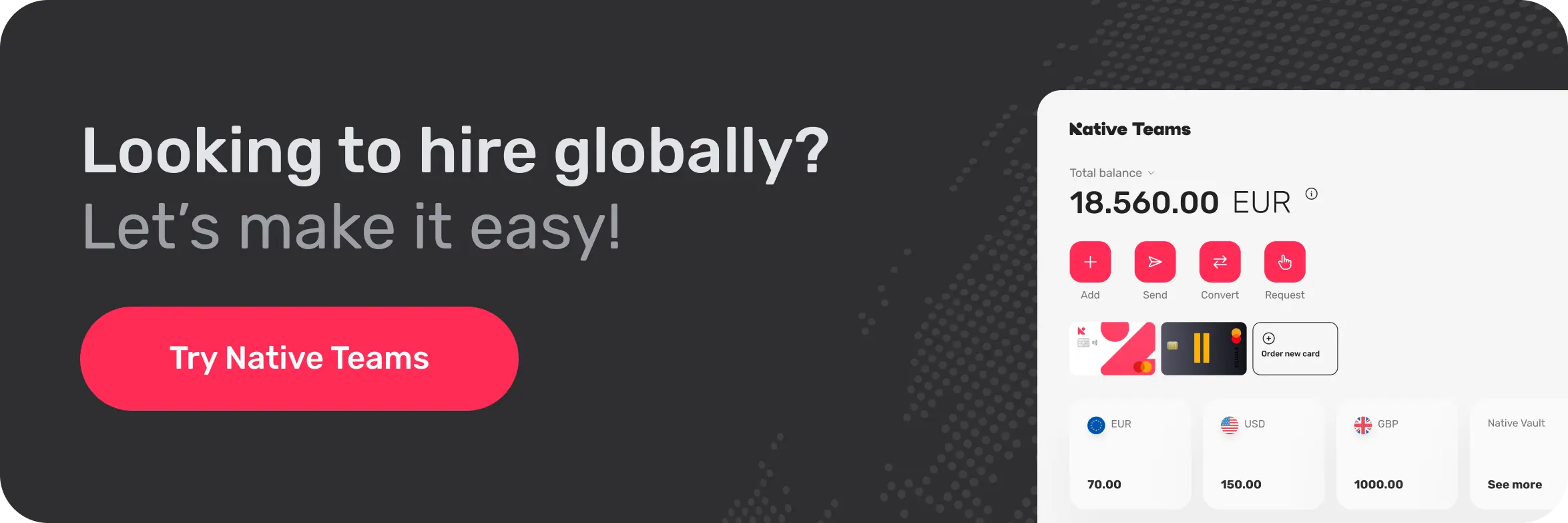
Employment
Legal employment for your global team
EOR (Employer of Record)
Your global team, locally employed
Entity Management
Set up and manage entities
HR, Payroll & Benefits
Manage all admin tasks from one place
Global Employee Benefits
Premium benefits for your global team
Relocation and Visa
Relocate your team anywhere
Employment Contracts
Localised employment contracts
Co-employment
Co-employment is a work arrangement where two entities share legal responsibilities for the same employee. This joint employment model is commonly used in global hiring, Professional Employer Organisation (PEO) services, and temporary staffing arrangements.



Back to Glossary
What is co-employment?
Co-employment is a legal and operational relationship where two organisations, typically a business and a third-party provider, share employer responsibilities for a worker. These responsibilities can include payroll, benefits, taxes, compliance, and even disciplinary action.
In most cases, one party (often the business) manages day-to-day operations, while the other (often a PEO or Employer of Record) handles HR, legal, and administrative duties.
How does co-employment work?
In a co-employment setup, the responsibilities of employment are split between:
- The client company, which supervises the employee's work, goals, and performance
- The co-employer (e.g., a PEO or EOR), which handles HR, payroll, legal, and tax compliance
This structure allows businesses to hire in regions where they don’t have a legal entity, or where managing employment independently would be too complex or risky. Each party is accountable for specific aspects of the employment lifecycle, typically defined by a service agreement.
“Co-employment offers growing businesses a compliant way to expand globally without sacrificing employee experience.” –HR Operations at Native Teams
Common co-employment scenarios
Co-employment isn’t limited to one industry or business model. Here are a few typical use cases where this structure adds value and efficiency.
PEO partnerships
When businesses engage a Professional Employer Organisation (PEO), both the business and the PEO become co-employers. The PEO manages benefits, taxes, and compliance, while the business retains control over daily tasks and performance.
Global hiring via Employer of Record (EOR)
An Employer of Record (EOR) acts as the legal employer on behalf of a company that wants to hire talent in foreign countries. In this co-employment model, the EOR ensures legal compliance while the client business directs the employee’s work.
Temporary staffing
Temporary or contract workers hired through staffing agencies often fall under a co-employment model. The agency handles payroll and HR, while the client business supervises the work.
Is co-employment legal?
Yes, co-employment is legal in many countries, but the rules vary by jurisdiction. To stay compliant, businesses must clearly define the roles and responsibilities of each party and ensure employment contracts are properly structured.
Some legal systems scrutinise co-employment arrangements closely, particularly in cases of tax liability, termination, or benefits disputes. Working with a reputable EOR or PEO helps reduce the risk of legal complications.
What are the benefits of co-employment?
Co-employment brings several advantages to both employers and employees. Let’s break down how each side benefits from this shared-employer model.
For employers
- Global expansion without entity setup: Businesses can hire internationally without establishing a legal entity in each country.
- Reduced compliance risks: Employment regulations are handled by experts familiar with local laws.
- Simplified HR and payroll: Administrative tasks are outsourced, saving time and resources.
For employees
- Access to local benefits: Employees receive benefits in line with local standards and expectations.
- Legal protection: Employees are formally employed through a regulated process.
- Professional onboarding and support: EORs and PEOs provide clear communication and structured HR services.

What are the risks of co-employment?
While co-employment offers flexibility, there are potential risks if not managed properly:
- Misclassification: Employees must be clearly distinguished from independent contractors.
- Liability confusion: Unclear division of responsibility can lead to legal disputes.
- Compliance issues: Failing to comply with local labour laws may result in fines or legal action.
To reduce these risks, work with a trusted provider like Native Teams that offers clear agreements, local expertise, and full legal compliance.
Co-employment and Employer of Record (EOR)
Although similar, EOR and co-employment are not always identical. With EOR, the provider becomes the full legal employer for tax, payroll, and compliance purposes, while the client directs the employee's tasks. This creates a form of co-employment, but with the EOR bearing more legal weight.
How Native Teams supports co-employment?
At Native Teams, we simplify global hiring through our compliant Employer of Record services. We handle the legal, tax, and administrative responsibilities while you focus on your team’s success.
Whether you’re expanding into a new market or hiring remote workers across borders, we provide a seamless co-employment experience that supports both your company and your team members.
Key takeaways
- Co-employment means shared responsibility between two employers.
- It’s common in PEO, EOR, and temporary staffing arrangements.
- Legal compliance is crucial to avoid risks and penalties.
- Native Teams offers co-employment support through our EOR solution, ensuring smooth global hiring.
FAQs about co-employment
1. Is co-employment the same as outsourcing?
Not exactly. Outsourcing usually refers to contracting an external company to perform specific services. Co-employment involves shared legal responsibility for employees, which outsourcing does not.
2. Can co-employment reduce compliance risks?
Yes. Working with an experienced co-employer, like a PEO or EOR, helps navigate complex local regulations and reduces the likelihood of non-compliance.
3. Do both employers need to sign the employment contract?
Typically, the legal employer (e.g. EOR or PEO) signs the employment contract. However, a service agreement will outline the responsibilities of the client company.
4. Who pays the employee in a co-employment model?
The co-employer (e.g. EOR or PEO) handles payroll, while the client company reimburses them according to their agreement.
5. What happens if the employee is terminated?
Termination must follow local employment laws. The legal employer (EOR or PEO) initiates the process, but the client company usually decides when and why an employee should be let go.